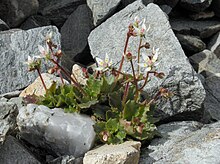Saxifraga stellaris
| Saxifraga stellaris | |
|---|---|
 |
|
| S. stellaris subsp. stellaris | |
| Scientific classification | |
| Kingdom: | Plantae |
| (unranked): | Angiosperms |
| (unranked): | Eudicots |
| (unranked): | Core eudicots |
| Order: | Saxifragales |
| Family: | Saxifragaceae |
| Genus: | Saxifraga |
| Section: | S. sect. Micranthes |
| Species: | S. stellaris |
| Binomial name | |
|
Saxifraga stellaris L. |
|
| Subspecies | |
|
|
| Synonyms | |
|
Micranthes stellaris (L.) Galasso, Banfi & Soldano |
|
Micranthes stellaris (L.) Galasso, Banfi & Soldano
Saxifraga stellaris, the starry saxifrage or hairy kidney-wort, is an Arctic–alpine species of saxifrage. It produces panicles of 5–10 white flowers on a stem up to 20 cm (7.9 in) tall, rising from a basal leaf rosette. One subspecies is found from eastern Canada to Russia, including the British Isles, while another is found in the mountains of southern Europe.
Saxifraga stellaris grows as a leaf rosette, which produces a generally leafless stem up to 20 centimetres (7.9 in) tall. The leaves are toothed and somewhat fleshy, ovate or obovate, and without an obvious petiole. They are typically 3 cm (1.2 in) long (varying from 1 to 5 centimetres or 0.4 to 2.0 inches), with a cuneate (wedge-shaped) base.
The flowers are borne in a loose panicle comprising 5–10 flowers; each flower has deflexed sepals, surrounding five white petals, 3–6 millimetres (0.12–0.24 in) long, with two yellow or red spots near the base. The anthers are also red or yellow. Flowers are borne from June to August.
The seeds are dark brown, glabrous, 0.6–0.8 mm (0.024–0.031 in) long, and 0.3–0.4 mm (0.012–0.016 in) wide. They are elliptic, ovoid or reniform in shape, with longitudinal ribs bearing spines.S. stellaris has a chromosome number of 2n = 28.
Saxifraga stellaris has an Arctic–alpine distribution. It is found from Baffin Island, Labrador and Greenland to Arctic Russia, including Iceland, Scandinavia and the British Isles. Further south, it is found from the Sierra Nevada in southern Spain to the eastern Carpathians, including lower ranges such as the Massif Central.
...
Wikipedia
